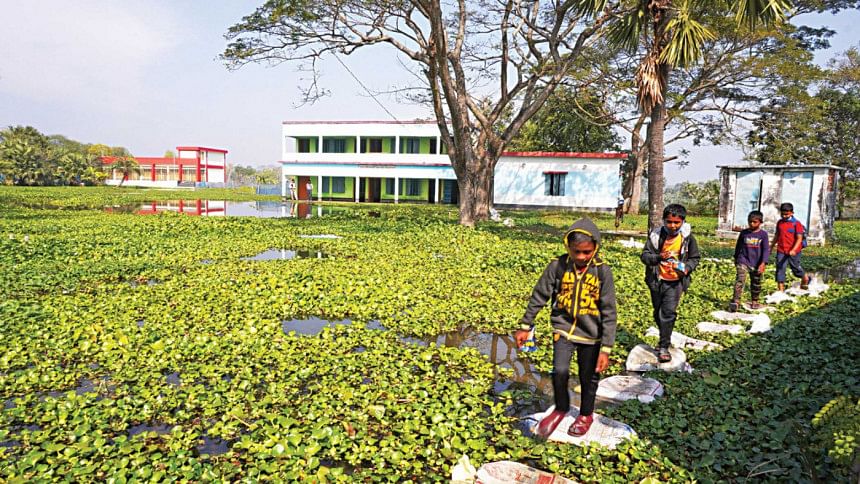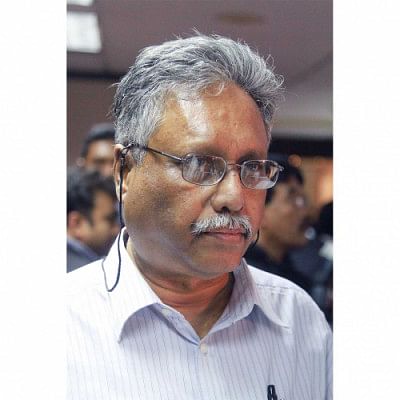‘Social engineering is vital to solve waterlogging in Bhabadaha’


Dr Ainun Nishat, professor emeritus of BRAC University and a water resource and climate change specialist, talks to Naznin Tithi of The Daily Star about the reasons behind the persistent waterlogging problem in the Bhabadaha area and the measures that should be taken to solve it.
It's hard to believe that over a million people in Bhabadaha in the country's south-west region have been suffering from waterlogging for so long. When did the problem start and how did it get so bad?
The waterlogging problem has been there in Bhabadaha for the last 30 years, which is the result of development activities in the sixties and the seventies. This is the result of an absence of monitoring, greed of a group of people, and the inability of the local community to push for their own agendas and ideas. In any development project, when you intervene or interfere with the natural process, you need to monitor and see what is happening. But the Water Development Board has failed to do so in the case of Bhabadaha. There are also many other factors involved.
In the coastal areas of Bangladesh, polders were constructed to protect crops from the high tide (during hide tide, croplands would go under water) and for land building. A hundred years back, these polders were called "Oshtomashi Baadh"—or, embankments that would remain functional for eight months of the year. During this period, crops would be protected and harvested, and at the beginning of monsoon, it would be cut down for the tide to come in. Together with the tide would come sediment, which would get deposited and land would be raised. Although it takes time for the land to be raised through this process, it was going on.
"Polder" is a Dutch word that basically means any embankment that prevents the movement of water from the river to inland. When it is linear, we call it an embankment. But when it encircles an area, we call it a polder. Currently, the entire coastal area of Bangladesh is empoldered—we have around 129 of them.
Around the time of 1965/1966, when the master plan for the overall water management of Bangladesh was prepared for the first time, the demand for building permanent polders came up. A US consultant with USAID funding, in consultation with the local people, decided to build polders around the entire coastal belt of Bangladesh. Before these polders were constructed between 1965 and 1969, tides used to come in and reach the beels or wetlands. The tidal volume was very high during monsoon—about 6 million metre cube. It would come naturally with the tidal water. The 10 to 12 large beels in the Bhabadaha area used to be filled up with the tidal sediment during monsoon.
But as the permanent polders were built around the beels, the land building process inside the polders stopped because water could not enter into the polders with sediments. The tidal volume then got deposited in the surrounding rivers, reducing their depth and width. The result is, the poldered areas became lower than the riverbed, creating waterlogging during monsoon. This problem became severe especially in Keshabpur, Abhaynagar, Dumuria and Tala upazilas of Jashore, Khulna and Satkhira in the early nineties.
To sum up, the waterlogging problem in Bhabadaha is a result of polderisation. I am not against polders. Without polders, the agricultural revolution in the south-western Bangladesh would have never been possible. After the polders were constructed in the sixties, for the first twenty years it produced excellent results. And then, in some areas, such as the Bhabadaha, the problem started to surface. And that was the time when shrimp cultivation was introduced. So, one group of the community—the powerful elite—didn't bother about the poor farmers and made money by farming shrimp.
However, the polder system is still functioning in Cox's Bazar, Chattogram, Noakhali, Laksmipur, Patuakhali and Barisal because the tidal cubature in these areas is still good with fresh water coming from the upstream. But in the south-western part, the behaviour of the polders became different due to the extensive network of rivers. In the Bhabadaha area, especially in Keshabpur, Abhoynagar, Dumuriya and Tala upazilas of Jashore, Khulna and Satkhira, fresh water supply from the upstream has decreased because of Farakka barrage and the tidal cubature has also declined.
Has anything substantial been done by the authorities so far to solve the issue? Reportedly, the Bhabadaha Pani Nishkashan Sangram Committee has been protesting the projects undertaken by the Water Development Board. Why?
Around 1977/78, when the government took up the delta development project, these facts were revealed and we requested a new management approach for the polders. Then in the nineties, the government undertook a project to stop the tide by constructing regulators across the river system. But the local people and the civil society organisations opposed it, demanding fresh studies to deal with the issue. The local communities, based on their traditional knowledge and wisdom, demanded implementation of the Tidal River Management (TRM) method.
Through this approach, an embankment is built around a beel leaving two cut-points for water to enter and recede from. When the water recedes during low tide, it takes the sediment deposited on the riverbed in a process of natural excavation. Under this method, water can be allowed to enter the tidal basin (the beel) for land building. In the course of a few years, the empoldered area becomes higher than the surrounding riverbed.
Although the government and the engineers of the Water Development Board were against it, the local people started implementing TRM near Chuknagar in Dumuriya upazila of Khulna. After this first TRM initiative was successfully applied by the local community, fresh studies were carried out and the TRM was approved as the technical solution of the problem. But the powerful elites of the area and the local members of parliament did not want the method to be implemented. Government officials sided with the elites. They wanted waterlogging to be there so they could cultivate fish and shrimp. But the decision was suicidal for the local communities, because they could not cultivate paddy, their main food.
During the last 15 years, the government undertook various projects for dredging the rivers and to pump out the stagnant water from the area. But, no amount of dredging will be able to lower the riverbed level. It will get filled up in two/three years. Also, people can get only temporary benefits by pumping out water from the beels.
So, what should be done now to push the authorities to implement the TRM approach, since this is the most efficient way to solve waterlogging in the area, according to experts and locals?
We need "social engineering" to solve the waterlogging problem of Bhabadaha—you need to allow the tide to come in and deposit the sediment in an organised manner. Doing so needs community involvement. But the WDB engineers traditionally like to work through the contractors, not through the community. Recently, the local community completed one TRM project in the Pakhimara Beel of Tala upazila in Satkhira, which has been quite successful. But the powerful local elites and the local MPs would always make attempts to foil the efforts taken by the locals.
Very recently, the government took up a project to implement TRM and go for land building, but the ministry itself opposed it.
As I have mentioned, the situation gradually deteriorated over the last 30 years. In the first 20/25 years, villagers reaped a lot of benefits from the polders. But now the hydro-morphological, tidal hydrodynamics and sediment transport mechanism has been totally altered. This requires a fresh assessment of the ground realities.
The waterlogging problem in Bhabadaha must be seen as a national problem. And the solution today would be to form a national commission with professionals from BUET and other experts who understand this particular problem and can solve it with the participation of the local people.
Needless to say, TRM is the ultimate solution. The Water Development Board should be instructed to push for implementing TRM in the Bhabadaha area. But they will have to fight with the local elites and their powerful backers who prefer using the land for shrimp cultivation. So, I think only the government can undertake this challenge, and they should not side with the powerful people at the expense of ordinary citizens.

 For all latest news, follow The Daily Star's Google News channel.
For all latest news, follow The Daily Star's Google News channel. 



Comments